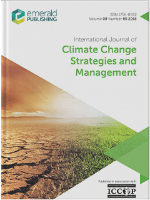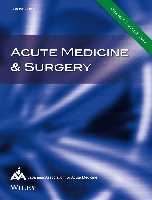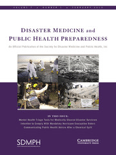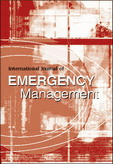
Australian Journal of Emergency Management
Scope & Guideline
Pioneering insights in emergency management.
Introduction
Aims and Scopes
- Disaster Preparedness and Resilience Planning:
The journal emphasizes the importance of preparing communities for disasters through effective planning, risk assessment, and resilience strategies, including community engagement and capacity building. - Animal Disaster Management:
A unique focus on the intersection of animal welfare and disaster management, addressing the needs of pets and livestock during emergencies and the role of animals in disaster recovery. - Community Involvement and Social Resilience:
Research on how community networks and social connections can enhance resilience and improve emergency management outcomes, including the role of marginalized groups. - Climate Change and Environmental Hazards:
The journal explores the impacts of climate change on disaster frequency and severity, promoting adaptive strategies and innovative solutions for managing environmental hazards. - Technological Innovations in Emergency Management:
An interest in the application of new technologies, such as social media, data analytics, and predictive modeling, to enhance disaster response and recovery efforts. - Policy and Governance in Disaster Management:
The journal addresses the need for effective policies and governance frameworks that support integrated disaster risk management at local, national, and international levels.
Trending and Emerging
- Community-Led Initiatives:
There is a growing emphasis on community-led disaster preparedness and recovery efforts, highlighting the importance of local knowledge and grassroots involvement in emergency management. - Mental Health and Wellbeing:
An increasing number of publications focus on the mental health impacts of disasters, addressing the psychosocial aspects of recovery and the importance of support services. - Intersectionality in Disaster Management:
Research exploring the diverse experiences of different demographics during disasters, including gender, disability, and cultural perspectives, is gaining traction. - Integration of Indigenous Knowledge:
The incorporation of Indigenous knowledge and practices in disaster management is emerging as a critical area of research, promoting culturally appropriate responses. - Innovative Communication Strategies:
There is a trend towards exploring the effectiveness of communication strategies during emergencies, including the use of social media and technology to disseminate warnings and information. - Sustainability and Climate Resilience:
The journal is increasingly focusing on sustainable practices in disaster management, including climate adaptation strategies that promote long-term resilience.
Declining or Waning
- Traditional Emergency Response Models:
There is a noticeable decrease in papers focusing solely on traditional emergency response frameworks, as the journal increasingly emphasizes integrated and community-based approaches. - Focus on Purely Scientific Research:
The journal has shifted towards more applied research that incorporates community perspectives, practical implications, and interdisciplinary approaches, leading to fewer papers that are purely theoretical or scientific. - Centralized Disaster Management Approaches:
Research that advocates for top-down, centralized approaches to disaster management is becoming less common, as the focus shifts towards decentralized, community-led initiatives.
Similar Journals

International Journal of Climate Change Strategies and Management
Exploring interdisciplinary strategies for climate resilience.Introducing the International Journal of Climate Change Strategies and Management, a premier publication dedicated to advancing the understanding and development of innovative strategies addressing climate change. Published by Emerald Group Publishing Ltd in the United Kingdom, this journal has established itself as a trusted source within the realms of development, geography, and environmental science. With an impressive 2023 impact factor reflecting its high citation rates and a Q1 classification in pivotal categories such as Development and Geography, the journal stands at the forefront of climate change discourse. Since adopting an Open Access model in 2018, it has broadened its reach, making cutting-edge research accessible to a global audience. The journal encompasses a wide array of topics essential for academics and practitioners alike, focusing on management, policy-making, and methods for effective monitoring of environmental strategies. By fostering interdisciplinary dialogue, the International Journal of Climate Change Strategies and Management is essential for those aiming to contribute to sustainable solutions in our rapidly changing world.

Australasian Emergency Care
Enhancing Emergency Care Through Knowledge and Research.Australasian Emergency Care, published by ELSEVIER SCI LTD, stands out as a premier journal in the field of Emergency Nursing, currently holding a prestigious Q1 ranking and positioned in the top 85th percentile according to Scopus metrics. With an E-ISSN of 2588-994X, this journal has been a vital platform for disseminating cutting-edge research since its inception in 2018. Focused on enhancing the practice, education, and research surrounding emergency nursing, Australasian Emergency Care serves as an essential resource for clinicians, educators, and researchers, offering access to a wide array of high-quality peer-reviewed articles. The importance of this journal lies in its commitment to improving patient outcomes through evidence-based practices and innovations in emergency care, making it a pivotal resource for anyone dedicated to advancing their knowledge and expertise in this critical field.

JOURNAL OF RISK RESEARCH
Navigating the Landscape of Risk Across Diverse FieldsJOURNAL OF RISK RESEARCH, published by Routledge Journals, Taylor & Francis Ltd, is a prestigious academic journal dedicated to advancing the understanding of risk across diverse fields, including engineering, safety, social sciences, and management. With its impact reflected in its Q1 quartile rankings in multiple categories and a solid standing in Scopus rankings, this journal serves as an essential resource for researchers, professionals, and students aiming to explore the complexities of risk analysis and its implications in real-world scenarios. The journal has been consistently publishing high-quality research since 1998, contributing to both theoretical frameworks and practical applications. While not open access, the content of the journal is invaluable for those keen on staying at the forefront of risk research. By addressing the multifaceted nature of risk, including safety, reliability, and strategic management, the JOURNAL OF RISK RESEARCH plays a vital role in shaping contemporary discussions and innovations in risk management and decision-making.

Prehospital and Disaster Medicine
Uncovering Best Practices for Disaster PreparednessPrehospital and Disaster Medicine is a leading peer-reviewed journal published by Cambridge University Press that targets the ever-evolving fields of emergency medicine and disaster management. With an ISSN of 1049-023X and an E-ISSN of 1945-1938, this journal has established its significance within the academic community since its inception, with coverage extending from 1985 to the present. It is widely recognized within its category as evidenced by its 2023 rankings, which position it in the Q2 quartile for both Emergency Medicine and Emergency Nursing. The journal boasts impressive Scopus rankings, standing at Rank #7/32 in Emergency Nursing and Rank #31/109 in Emergency Medicine, demonstrating its relevance and impact in these critical areas. Although it does not offer Open Access, Prehospital and Disaster Medicine is committed to disseminating vital research and innovative practices that address prehospital care, disaster response, and the intersection of these fields, serving as an essential resource for researchers, professionals, and students alike.

Acute Medicine & Surgery
Bridging the gap between acute medicine and surgical excellence.Acute Medicine & Surgery is a notable peer-reviewed journal published by WILEY, focusing on the dynamic intersection of acute medicine and surgical practice. With an ISSN of 2052-8817, this open-access journal has been committed to disseminating high-quality research since its transition to open access in 2017. Aimed at an audience comprising researchers, clinicians, and students in the medical field, it facilitates broader access to innovative studies that enhance understanding and practice within acute care settings. The journal covers a wide range of topics, including emergency medicine, trauma care, critical analysis of surgical techniques, and best practices in clinical management. By providing a platform for cutting-edge research and case studies, Acute Medicine & Surgery plays a pivotal role in improving patient outcomes and advancing the field of acute healthcare.

Disaster Medicine and Public Health Preparedness
Elevating standards in emergency preparedness research.Disaster Medicine and Public Health Preparedness is a pivotal journal published by Cambridge University Press, dedicated to advancing the field of disaster medicine and public health. With an ISSN of 1935-7893 and an E-ISSN of 1938-744X, this journal holds a commendable place in the academic discourse, featuring a 2023 Scopus ranking of #221 out of 665 in the category of Public Health, Environmental and Occupational Health, placing it in the 66th percentile. It enjoys a Q2 quartile ranking, which underscores its significant contributions to the field. The journal, spanning from 2007 to 2024, serves as a critical platform for researchers, professionals, and students aiming to share innovative findings and best practices in preparing for and responding to public health emergencies. Though not available as Open Access, its rigorous peer-review process ensures high-quality publications that are relevant in addressing contemporary challenges in disaster preparedness. Operating out of the UK, specifically from Edinburgh Building, Shaftesbury Rd, Cambridge, this journal plays an integral role in policy formulation and educational efforts in public health, making it an essential resource for scholars intending to impact the sector meaningfully.

International Journal of Emergency Management
Fostering collaboration for a safer, more prepared global community.International Journal of Emergency Management is a reputable publication within the fields of emergency medicine and strategic management, published by InderScience Enterprises Ltd. With its ISSN 1471-4825 and E-ISSN 1741-5071, this journal has been a crucial platform for scholarly research since its inception in 2003. The journal aims to disseminate high-quality, peer-reviewed articles that address critical issues related to emergency management, including but not limited to disaster preparedness, response strategies, recovery methods, and risk assessment. Despite being categorized in Q4 of both emergency medicine and strategy and management in 2023, the journal serves as an essential resource for researchers, professionals, and students looking to further explore the evolving dynamics of emergency management. It leverages its global presence, with its headquarters located in the United Kingdom, thus attracting a diverse array of contributions addressing international and interdisciplinary perspectives. The journal fosters an environment where innovative ideas can flourish, ultimately contributing towards enhancing global emergency management practices.

International Journal of Disaster Risk Reduction
Fostering collaboration for a disaster-resilient world.The International Journal of Disaster Risk Reduction is a leading academic publication dedicated to advancing the understanding and management of disaster risks, promoting innovative solutions and effective strategies for risk reduction. Published by ELSEVIER, this journal serves as a critical platform for researchers, professionals, and students in the fields of Geology, Geotechnical Engineering, and Safety Research. With an impressive impact factor and ranked in the top quartile (Q1) across its various categories as of 2023, it demonstrates exceptional quality and relevance in its contributions to science and engineering disciplines. The journal has been committed to disseminating high-quality research since its inception in 2012 and remains open for new submissions through 2024. The Scopus rankings reflect its prestigious position, with notable placements in Earth and Planetary Sciences and Social Sciences, highlighting its influence in shaping best practices for disaster risk governance. As an essential resource for anyone involved in disaster preparedness and mitigation, the International Journal of Disaster Risk Reduction fosters knowledge exchange and collaboration among stakeholders in the global community.

Risk Hazards & Crisis in Public Policy
Advancing insights for resilient public administration.Risk Hazards & Crisis in Public Policy is a leading academic journal published by WILEY, focusing on the interdisciplinary study of risks and crises as they pertain to public policy. Since its inception in 2010, this journal has established itself prominently in the field, currently holding a Q2 quartile ranking in Public Administration and boasting an impressive Scopus percentile of 89, ranking it 24 out of 232 journals in its category. This demonstrates its significant influence and relevance among peer-reviewed publications. The journal serves as a critical platform for researchers, policymakers, and practitioners to share innovative research, insightful analyses, and practical solutions related to the management and mitigation of risks in public administration. Although it does not currently offer open access options, it continues to provide vital insights into burgeoning issues within the domain, making it an essential resource for anyone interested in advancing their understanding of risk management in public policy contexts.

Frontiers in Emergency Medicine
Championing open-access knowledge for emergency medicine.Frontiers in Emergency Medicine, published by Tehran University of Medical Sciences, stands as an essential open-access platform dedicated to advancing research and practice in the diverse fields of emergency medicine, nursing, and medical services. With a focus on publishing high-quality studies that address the emerging challenges in prehospital and emergency care settings, this journal has rapidly gained recognition since its inception in 2021. The journal's current Scopus rankings place it favorably within the top quartiles for emergency medical services and emergency nursing, making it a valuable resource for researchers and practitioners aiming to enhance patient care and operational efficiency in emergency contexts. The journal encourages submissions that explore innovative practices, clinical outcomes, and policy developments in emergency medicine, promising accessibility and visibility for authors through its open-access model. Located in Iran, Frontiers in Emergency Medicine not only serves the regional community but also aspires to impact the global discourse in emergency healthcare.